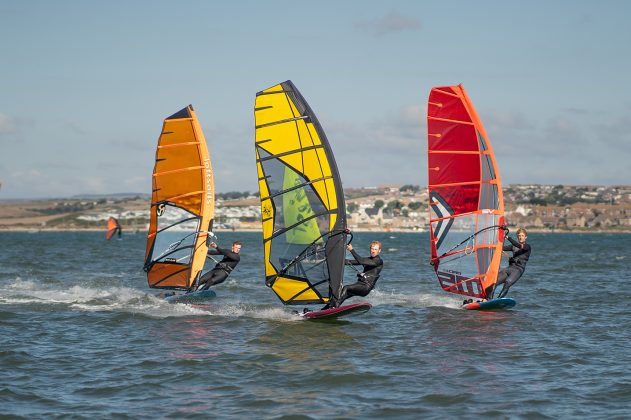2022 8.0 MULTI-CAM SAIL TEST: CAMBER CHOICE
The test team get their speed fix with a review of some of the latest 8.0 multi-cam sail designs.
EDITOR: TRIS BEST // SECOND TESTERS: ROB YORK, SCOTT STALLMAN AND JAMES FALEY
PHOTOS: OLLIE ROGERS // LOCATION: PORTLAND HARBOUR
Camber inducers are certainly not a new concept in the windsurfing world. Indeed, in the early nineties, it was not uncommon to witness every single batten in a brand’s full race sail possessing their own little plastic collar with which to cup the mast, which often meant seven in a sail! Rigging was a nightmare; the sails were stiff and unforgiving to use and their durability was very questionable … but it was all worth it if the sail was stable! Stability meant the sail could be used in stronger winds; the ability to hold the sail down in stronger winds provided a better chance of translating it into faster speeds, and ultimately the capacity to win races. And so, the simplest equation was utilised – the more cams a sail had, the more stable it was, right? It degenerated into an arms race and meant the consumer market was being taken for a jolly by the goings-on of the professional world tour. Inevitably, there was a backlash, and the no-cam sail was conceived and championed by Naish in the seven batten no-cammed Noa, which largely served to give camber inducers a rotten name.
Time has marched on since, and today the cam enjoys a much more positive limelight and publicity, as most appreciate their value and understand their limitations. For example, no longer is a cammed sail time-consuming or complex to rig – all can be rigged without putting the boom on. There is certainly a knack to it, but once you’ve got it, a cammed sail is as easy to rig as a rotational.
FINDINGS
With the stability and structure that cams provide, there’s a consensus amongst the brands that they should be incorporated to fulfil one of three tasks (or a combination of the three): bottom end power, top end performance, and wind foiling. And whilst these three targets aren’t mutually exclusive by any means, it’s hard to factor in design features and attributes with all three in mind in equal measure. The ten sails on test here host two, three or four cams respectively and it remains largely true that the more cams installed, the more the sail is focussed on top end stability. The accepted conventional trade-off tends to be user-friendliness … and yet modern sail shaping and technology has demonstrated that a full race sail is light and manageable enough so that it’s within easy reach of the ambitious recreational sailor. What they do demand is more nuanced and subtle. They require time and appreciation invested, as they’re not simply plug and play to get the most of them, they need to be tuned and tinkered with for your setup and conditions. They also need to be partnered with other components that can do them justice, not least a performance mast, board and fin. It’s akin to the analogy of buying a Ferrari and putting pram wheels on it – you’ll need to invest! My suggestion is to decide the level of sailing and investment you wish to partake in and pitch your search respectively.
SUMMARY
We’ll start with looking at the twin cams, and the Gunsails Exceed is a great example of the freeride performance a two-cammed sail can provide, with good bottom end power and excellent natural wind range, making it a real plug and play champion and all at a fantastic retail price too. The Mark 2 from Goya is a beautifully engineered sail and delivers plenty of power and torque for making the most of light to comfortably powered conditions. The S Max from Simmer is a similar proposition, yet with a little more tuning range it can cater for everything from light wind foiling to balanced high wind freeride blasting. There are then two other twin cams that break the mould slightly. The AC-Z from Point-7 is unique in nature and geometry, with both its cams located below the boom. It feels big and bold in the light airs, yet has masses of drive and acceleration when the wind is pumping. There’s also Neil Pryde’s V8 – a name steeped in heritage from the brand’s past. With the cams and design-craft adopted directly from the brand’s race programme, it’s amazing the performance this twin cam is capable of. In the three-cam category we have the Switchblade from Loftsails – a large natured freerace engine that thrives on being powered or even overpowered, exhibiting stunning stability in its form. There’s the Phantom from GA Sails with its supremely light and agile performance that would be a match for anything at national level. And finally, there’s the all-round Duotone S_Pace, a sail with an incredible amount of tuning range and with it plenty of versatility in its capability and uses. Onto four cams and the X-Wing from RRD is the quintessential racing engine, taking a little time to come into its own as the wind turns on, but offering jaw-dropping acceleration and stability off the wind, when others are folding. And we end with the Mach 5 from Severne – a brand on a constant quest to reduce physical weight and improve handling, and this pure race engine in no exception. It is a stunning example of what is possible today and if you have the finances to invest properly, we’re sure that you won’t regret it.
THE LINEUP

